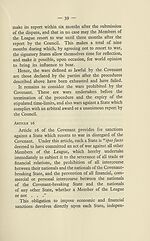Download files
Complete book:
Individual page:
Thumbnail gallery: Grid view | List view

- 38
Article 13
This article, which deals with the first of the methods
proposed—the method of judicial settlement (i.e.3
settlement by a permanent international tribunal, the com¬
position of which remains unchanged—in fact, by the
Permanent Court of International Justice) or arbitration
(i.e.y settlement by one or more international arbitrators
chosen by mutual agreement between the parties)—
leaves it to the parties to decide whether the dispute is
suitable for settlement by either of those means (para¬
graph 1). It also enumerates the types of disputes which,
in practice, have been found to lend themselves most
readily to those methods of settlement. These are
“ disputes as to the interpretation of a treaty, as to any
question of international law, as to the existence of any
fact which, if established, would constitute a breach of
any international obligation, or as to the extent and
nature of the reparation to be made for any such breach
Article 15
Should the parties not have recourse to judicial settle¬
ment or arbitration, serious disputes arising between
them may, under Article 15, be submitted by one of the
parties to the Council. The latter may itself bring the
dispute before the Assembly; or, at the request of one of
the parties, the matter will be taken out of the hands of
the Council and referred to the Assembly.
We need not go into the details of the procedure laid
down in the Covenant for the examination of disputes by
the Council or Assembly. Suffice it to say that the
Covenant does not overlook the possibility that the
procedure of pacific settlement may fail. In that case,
the parties are required not to resort to war for a certain
period. It is stated in Article 12 that the Council must
Article 13
This article, which deals with the first of the methods
proposed—the method of judicial settlement (i.e.3
settlement by a permanent international tribunal, the com¬
position of which remains unchanged—in fact, by the
Permanent Court of International Justice) or arbitration
(i.e.y settlement by one or more international arbitrators
chosen by mutual agreement between the parties)—
leaves it to the parties to decide whether the dispute is
suitable for settlement by either of those means (para¬
graph 1). It also enumerates the types of disputes which,
in practice, have been found to lend themselves most
readily to those methods of settlement. These are
“ disputes as to the interpretation of a treaty, as to any
question of international law, as to the existence of any
fact which, if established, would constitute a breach of
any international obligation, or as to the extent and
nature of the reparation to be made for any such breach
Article 15
Should the parties not have recourse to judicial settle¬
ment or arbitration, serious disputes arising between
them may, under Article 15, be submitted by one of the
parties to the Council. The latter may itself bring the
dispute before the Assembly; or, at the request of one of
the parties, the matter will be taken out of the hands of
the Council and referred to the Assembly.
We need not go into the details of the procedure laid
down in the Covenant for the examination of disputes by
the Council or Assembly. Suffice it to say that the
Covenant does not overlook the possibility that the
procedure of pacific settlement may fail. In that case,
the parties are required not to resort to war for a certain
period. It is stated in Article 12 that the Council must
Set display mode to:
![]() Universal Viewer |
Universal Viewer | ![]() Mirador |
Large image | Transcription
Mirador |
Large image | Transcription
Images and transcriptions on this page, including medium image downloads, may be used under the Creative Commons Attribution 4.0 International Licence unless otherwise stated. ![]()
| League of Nations > Background to the League > Aims, methods and activity of the League of Nations > (40) |
|---|
| Permanent URL | https://digital.nls.uk/202447787 |
|---|
| Shelfmark | LN.1(23) |
|---|---|
| Attribution and copyright: |
|
| Description | Over 1,200 documents from the non-political organs of the League of Nations that dealt with health, disarmament, economic and financial matters for the duration of the League (1919-1945). Also online are statistical bulletins, essential facts, and an overview of the League by the first Secretary General, Sir Eric Drummond. These items are part of the Official Publications collection at the National Library of Scotland. |
|---|---|
| Additional NLS resources: |
|

